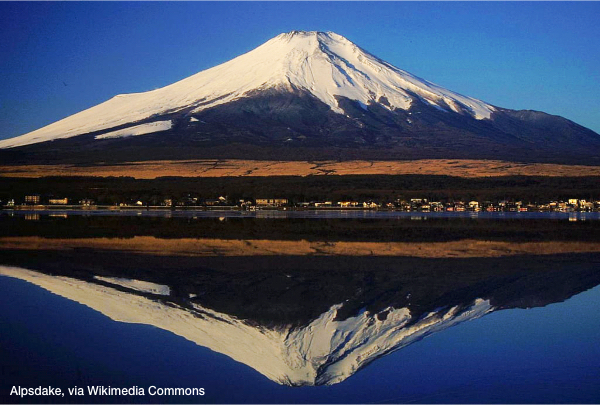Mount Fuji

Mount Fuji, the highest mountain in Japan, symbolizes Japanese contributions to Fermi science. Its conical shape, typical of stratovolcanoes, also calls to mind the path traced through Fermi's Large Area Telescope (LAT) by an electron and positron pair produced when a gamma ray converts from pure energy into matter.
There are two important things to bear in mind if you want to detect gamma rays. First, they are few and far between, and the higher the energy the fewer there are. Second, gamma rays carry such enormous energy — millions of times of times greater that visible light — they are difficult to stop. So the tracker in the LAT relies on a process called pair production, where gamma rays convert into a pair of charged particles — an electron and its antimatter counterpart, a positron. The tracker then follows the particles through the LAT to determine the direction of the original gamma ray.
When a gamma ray enters the LAT, it encounters layers of metal foils made out of tungsten and converts into an electron and a positron. This particle pair contains almost all of the energy and momentum of the original gamma ray, except for a small amount imparted to the tungsten nucleus.
The electron and positron continue on through layers of tungsten and silicon in the tracker. Each time they move through a layer of silicon they deposit a little bit of energy, and this energy is translated into digital signals. Finally, these particles deposit most of their energy in a dense detector called the calorimeter, made of cesium iodide bars. Astronomers build up a picture of energy deposits in the tracker and connect them with lines. The two tracks through the detector will converge at the point where the gamma ray first interacted with the LAT, helping us determine the sky position of the source. And by adding up the energy recorded as the particles moved through the tracker and calorimeter, astronomers can find the energy of the incoming gamma ray.
Naturally, computer algorithms keep tabs on particles moving through the tracker. By refining these methods, Fermi scientists were able improve all LAT observations to produce an expanded, higher-quality set of data called Pass 8. These changes effectively provided a major upgrade to the LAT's capabilities without ever having to leave the ground.